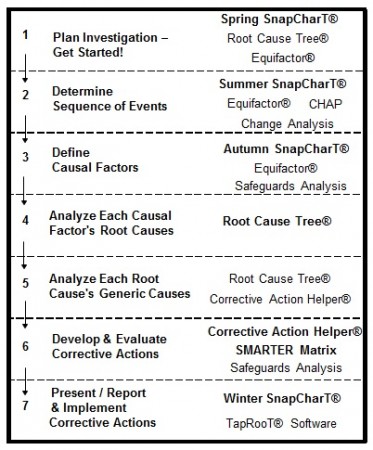What Does a Generic Cause Look Like in Healthcare?
I have been teaching RCA now for almost 20 years and have found that Generic Cause is many times the simplest yet most confusing step in our RCA process. The first 4 steps from Getting Started (reporting) through Root Cause Analysis (Root Cause Tree®) move very efficiently. But transitioning from “Specific” root causes linked to Causal Factors to “Generic” causes that tie multiple events together seems to trip up many professionals.

What is a Generic Cause?
First let me start with a quick discussion of our philosophy on Generic Cause. Step 5 in the process flow above addresses this issue prior to developing your Corrective Actions. We need to first understand the “Specific” root causes from Step 4, and the “Generic” causes before we begin developing Corrective Actions so both can be addressed.
The definition of a “Generic” cause in our system is as follows:
The Systemic problem that allows a root cause to exist, across multiple incidents or sites or systems.
This is a bigger picture issue that is allowing the same root causes to exist across multiple events. So that being said, let’s dig into the article above to provide a description of a “Generic” issue.
The Duodenoscope Example
The article discusses a particular type of duodenoscope produced by one manufacturer used across the healthcare industry. This particular scope had been linked to multiple cases where infection had been spread to patients. So similar infections, when investigated by individual hospitals, provided data showing that this particular type of scope was involved. Breaking down that statement, we have the following:
- Same brand and model duodenoscope
- Used in multiple facilities over a term of 5 years
- Multiple instances of infection transmission following use of this scope
Are you seeing the pattern in this list? Something is similar in all these instances… the scope itself. Now, from the article (which does not provide any RCA data), I can only speculate on the Root Causes for this “spread of infection” as it relates to the scope… from the Corrective Actions taken by the manufacturer it looks as if there could be any of the following issues:
. . . A. Equipment Difficulty->Design->Specs NI
. . . B. Equipment Difficulty->Preventative/Predictive Maintenance-> PM NI-> PM for Equip NI
. . . . . .1. If you assume the cleaning procedures and recommendations to be Preventative Maintenance
…………..on the scope
. . . C. Human Performance->Procedures->Wrong->Facts Wrong
. . . . . .1. If here you assume the cleaning instructions are procedures and they did adequately provide
…………..information on cleaning the scope.
Any of these could relate back to the Corrective Actions which include the recall, a redesign of the scope as well as changes to the cleaning requirements.
Finding Generic Causes in Your Organization
Now looking at these causes, and the list of items that meet the definition of a Generic cause, I have to ask everyone reading this article:
How would you as an organization know that you are having Generic problems?
The answer to that question will probably vary from organization to organization but there is probably one key element. That key element is consistent Classification of events, consistent Root Cause Analysis, linking your Causal Factors (on the Causal Factor Editor) to specific Equipment types and Departments, and effective trending and data analysis. Without a clear, well defined classification schema for all investigations or incidents within a healthcare facility/system it would be nearly impossible to trend your RCA data and determine where similar causes and events are happening.
Once you get a standard Classification list together, and consistently classify your events, you can now perform a couple of different Trending functions (from the TapRooT® Software v5.3) to determine Generic Causes:
- Search your data using our Root Cause Distribution Report by filtering Classification and over a date range to see all causes produced. If you find a particular root cause across those RCA’s you may have a generic cause.
- Run a Pareto Chart using Equipment as your X-axis and Counts as your Y-axis on the chart to look at counts. See if one piece of equipment is linked to 70-80% of your causes… this might give you a clue to a Generic Issue
- Run a Process Behavior Chart looking at a Specific Classification, and run an “Instant Rate” chart or an “Interval Chart”. These would cue you in on if your rate of failure is increasing or if your time between occurrences is decreasing respectively and may provide some insight into your overall Equipment or program health.
If you have any questions about Generic Cause or any additional Trending functions please feel free to contact me at skompski@taproot.com



